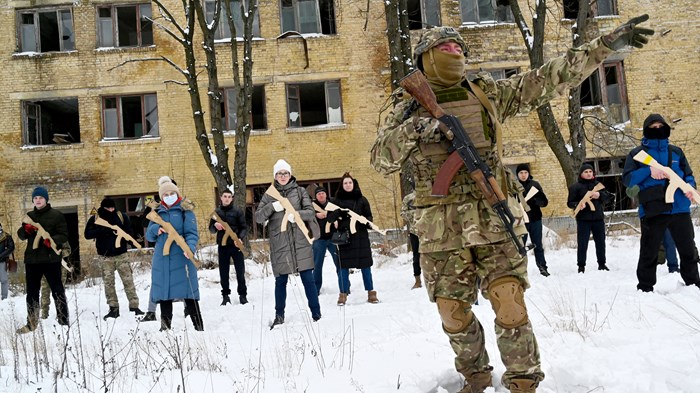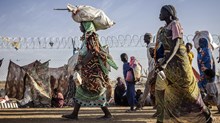
Ukrainian Baptists were once practical pacifists.
Now locked in a vicious war of survival with invading Russian forces, many are on the front lines of battle. Leading voices call for NATO to enforce a no-fly zone. Pastors pray for soldiers; churches offer bread.
What happened?
It is not as straightforward as simple self-defense. But neither was their nonviolence, practiced by most Slavic evangelicals, a clear convictional principle. Forged in the fires of the Soviet Union, the then-second-largest Baptist community in the world developed along a very different path from their denominational brethren in the United States.
Just ask Roman Rakhuba, who was raised Baptist.
“I never would have called myself a Mennonite,” said the head of the Association of Mennonite Brethren Churches of Ukraine (AMBCU). “Later I discovered I was following their principles all along.”
Known as the “Bible Belt” of Eastern Europe, Ukraine’s evangelical faith was greatly influenced by the Anabaptist tradition. Rakhuba grew up in Zaporizhzhia, 350 miles southeast of Kyiv, near the old oak tree associated with the Chortitza colony of Mennonites, founded in 1789.
His grandfather was saved through one of their preachers.
But as a Baptist child, Rakhuba was raised without toy guns, instructed to never return evil with evil. Forbidden from playing war, his relatives refused to fight in the Soviet army. He remembers Mennonites hosted at his grandfather’s home, learning of the 1763 decree by Catherine the Great to invite German settlers to develop the Russian hinterland.
They were joined by Lutherans and Catholics, dissidents and rebels, offered lands, self-governance, and—vital for the pacifists—exemption from military service. Over the next century, Mennonite communities thrived in Ukraine, developing infrastructure for agriculture and industry. But increasing prosperity challenged their social and spiritual life, and drunkenness and dancing became common.
Then came pietism.
In the mid-19th century, German missionaries, such as the Lutheran Edward Wuest, found a reception with the Mennonites. Their emphasis on a regenerated Christian life through personal conversion, prayer, and Bible study appealed to colonists dissatisfied with the traditional church. The community ruptured, and in 1860 a parallel Mennonite Brethren denomination was born, sending missionaries as far as Siberia and India.
The still-German speakers lived largely separate lives from their Slavic neighbors, until two events intervened to spark an evangelical revival. In 1858, Emperor Alexander II authorized the translation and printing of the Bible in Russian. Three years later, he abolished serfdom.
“For the first time, peasants were no longer tied to the land,” said Mary Raber, a church history instructor at Odessa Theological Seminary. “Where better to find a job than on the farm of a successful colony?”
Slavs, now with a New Testament to read, started joining their Bible studies.
Mennonites were not the only revivalist movement in the Russian empire. German Baptists planted churches in the Caucasus Mountains. An English missionary won converts among the St. Petersburg elite. Neither of these groups adopted pacifism as a rule, and even some Mennonites organized self-defense units to ward off bandits in the chaos of World War I.
But none were prepared for the rise of the Bolsheviks, communist revolutionaries who solidified power in 1923.
Not counting converts, in 1911 there were over 100,000 German-speaking Mennonites in Ukraine. But their population had already taken a hit in the 1870s, when military exemption was revoked and belatedly replaced with alternative service. One-third left for the central plains of North America.
Civil war and famine ravaged the community after World War I, and the Mennonite Central Committee (MCC), created in 1920 to assist brethren in Ukraine, provided relief. But though 25,000 daily meals saved many—an estimated 9,000 lives—another exodus led an additional 20,000 to join previous emigrants in Canada.
Soviet agricultural collectivization contributed to the Holodomor, a man-made famine a decade later, killing millions of Ukrainians. And like other Christians, Mennonites suffered arrest, execution, and exile to Siberia. World War II brought the deportation of thousands to Central Asia. Numbers continued to dwindle, and most of those remaining went west with the retreating German army.
When Joseph Stalin pandered to Western allies and created the Union of Evangelical Christians-Baptists in 1944 (later adding Pentecostals), Mennonites mostly just dissolved therein.
The persecution of Soviet Christians is a well-known story. Officially tolerated as international window dressing, they were marginalized in society with churches infiltrated by KGB agents. Evangelizing quietly at great risk, their biblical practice emphasized submission to authorities—even autocratic ones—in political affairs.
But like their Mennonite forerunners, they refused military service.
“It wasn’t exactly pacifism, it was nonparticipation,” said Michael Cherenkov, now pastor of Revival Baptist Church in Vancouver, Washington. “Maybe it was wise, but it was not theological—it was the experienced path of survival.”
Cherenkov grew up in the underground churches of Soviet Ukraine, and in the 1960s his Russian-born father was jailed for pacifism. His family grew up praying not only for spiritual revival, but also for the collapse of the USSR. It was a “theology of liberation,” he said, and in some ways represented a seed for the eventual support of armed resistance to Russia today. (In the hospital near the eastern frontlines of the war, his mother recently asked prayer only for the Ukrainian army.)
The family’s political prayers were answered in 1991 with Ukraine’s independence, and believers suddenly found themselves in a completely new reality. Christianity became an integral part of the new republic, Cherenkov said, and believers found freedom to shape public life and share the gospel.
But met with corruption, nominal faith, and lingering Soviet mentalities, they needed a new apologetic skill.
“We felt responsibility for the transformation of society,” he said. “Over time, we learned to defend.”
A second input to the process was the post-independence development of evangelical seminaries, largely funded and staffed from the West. Sergey Rakhuba, a non-Mennonite uncle of Roman and director of the pan-evangelical Mission Eurasia, said they were surprised to see the widespread pacifism of Ukrainian believers. Professors did not focus on it, he said, but new debates proliferated on all topics of theological dispute. Alongside Calvinism versus Arminianism and the Lordship of Christ, discussions emerged about the legitimacy of military service.
But doubts about nonviolence were already in bloom.
Valentin Siniy, president of the interdenominational Tavriski Christian Institute, downplays the role of seminaries in the development away from pacifism. He also believes the famous novelist Leo Tolstoy was more influential than the Anabaptists in its promotion.
But his own story illustrates the evangelical shift.
Experiencing a childhood similar to the Rakhuba and Cherenkov families, Siniy’s Baptist grandfather lost his job under Soviet persecution; his parents lost their home. Lessons were given about humility and nonresistance to evil. But in his young mind, it failed to compute.
God is on the side of the powerful, he concluded in resignation.
The seeming impotence of pacifism was driven home at age 14, when on his way home from church he witnessed a drunken man try to rape a young woman. Siniy was paralyzed, but the commotion stirred neighbors across the street and the assailant ran away.
Five years later, he joined in the defense of another would-be victim. Now a theologian amid a devastating war, he has discovered the power of biblical anathema: ‘Curse Meroz,’ said the angel of the Lord. ‘Curse its people bitterly, because they did not come to help the Lord … against the mighty’ (Judges 5:32).
Americans played a vital role, Siniy said, in setting fledgling Ukrainian efforts at evangelical theological education on a solid foundation. But the financial crisis of 2007–08 dried up much financial support, and local staff assumed positions of leadership. In the years since, foreign professors, far fewer in number, have been welcomed as partners.
Mennonite thought remained among older Ukrainians, Siniy said, as did the lingering Soviet conditioning away from political participation. But as younger seminarians challenged these notions theologically, tensions with Russia shook what had been a semi-deference to the “big brother” in evangelical relations. Their seminaries crafted joint programs to keep the peace between them, stimulated by stalwart Mennonite and Anabaptist-leaning leaders of the older generation.
And alongside these developments was a new commitment to social service.
“Our role as Christians is not only to fulfill the mission of God through salvation of souls,” said Siniy, “but also to strive to actively return this world to the divine plan, to the extent that we can.”
This includes participation in the armed defense of the nation, he said.
But applying differently a similar conviction, Mennonites also were serving society as foreign support contributed to the renewal of their theological heritage in Ukraine.
Emphasizing peacebuilding and development, MCC opened an office in Russia in 1992, and in cooperation with the Baptist Union of Ukraine relocated to historic Zaporizhzhia a few years later. Meanwhile, Multiply, the mission agency for the Mennonite Brethren, dedicated efforts to return to the lands from which they once fled famine.
John Wiens, 35 years a pastor in Canada, came to Ukraine in 2008. Building upon Mennonite work since the early 1990s, he planted new churches and social centers to unite a denominational family of faith. Serving especially the margins of society, his holistic ministry attracted new converts and other evangelicals, while memory of the Anabaptist tradition legitimized the movement locally.
“We were taught to respond to people in pain,” said Roman Rakhuba, who was elected conference moderator of the AMBCU in 2014. “The church should be useful in society.”
Almost all members in their two dozen churches are younger than 40 years old, or those who joined from other evangelical denominations. But the year 2014 marked a turning point for the Mennonite Brethren—and in fact, all of Ukraine.
Wiens succumbed to cancer in January. In February, the pro-Europe “Revolution of Dignity” removed a pro-Russian president and in return Russia occupied Crimea. And in March, Russia annexed the peninsula while Moscow-backed separatists seized control of the eastern Donbas region.
Ukraine was aflame, in hybrid—but very real—war.
MCC, which in the early 2000s refocused its peacebuilding work to the Balkans, scrambled to renew it again in Ukraine.
The relief agency organized conferences for Croatian, Bosnian, and Serbian experts to share insights on peace, justice, and reconciliation. They partnered with the Quaker Alternatives to Violence project to spark group reflection and personal transformation. And MCC supported a network of churches divided by the demarcation line in the Donbas, whose leadership expressed pacifism and a commitment to maintain unity.
The AMBCU didn’t know what to do.
“When we evangelize, the conviction of nonviolence is not our first priority,” said Johann Matthies, Multiply’s regional team leader for Europe and Central Asia. “We invite people to follow Jesus, not Menno Simons, and the idea of costly discipleship comes later.”
But despite bearing the classic Anabaptist name, some said that Mennonites were now virtually indistinguishable from Baptists in the question of armed defense. Wiens had died, two AMBCU members were drafted into the army, and Matthies stepped into the leadership void.
For their annual leadership conference in Dnipro, near Zaporizhzhia, he suggested consulting the Sermon on the Mount rather than recruiting some eloquent speaker. Participants read aloud the words of Jesus, each one sharing what the Holy Spirit brought to mind.
“For the first time, it was not an academic question,” Matthies said. “The enemy was at the gate.”
At a similar conference in Kyiv, Baptists were ready to fight. Three dozen pastors gathered in the capital to discuss events, and an elder leader stood up and said, “We are pacifists,” counseling that Ukraine could not stand up to such an evil superpower.
It did not go over well.
“Where the older generation was still traumatized, young leaders wanted to proactively address this aggression,” said Cherenkov, who spoke on behalf of an armed resistance. “Within a few months, sentiment shifted entirely.”
And without a context of oppression, said Sergey Rakhuba, there was little to reinforce a pulpit-driven message of nonviolence within the church. He draws the point of origin back to the 2004 Orange Revolution, when Ukrainians demonstrated in the thousands to protest a fraudulent election. And though this action divided evangelicals—submit to the authorities, many said—the plea to act as faithful citizens resonated among the youth.
But the Donbas made the difference.
“In 2014 they said, ‘If we don’t defend our country, who will?’” said Rakhuba. “That’s when pacifism began to crumble.”
Eight years later, Russian President Vladimir Putin recognized the independence of the two southeastern breakaway “republics.” Three days later, he launched a war.
Oleg Magdich, a 44-year-old nondenominational pastor, leads morning prayer for a territorial defense team of 80 civilians—only 10 of which have seen active combat. As Russian soldiers approached Kyiv, the Ukrainian volunteers spent their days building barricades of sand and cement blocks and attached explosives to the city bridges. They are now preparing to redeploy south.
Oleg Mironenko chose a different path, eventually. One of the two Mennonite Brethren conscripts in 2014, he first enrolled in the defense of the Donbas. The other requested alternative service. The church supported them both.
God spared him direct combat, as he was assigned as a driver for an artillery unit. Though traumatized from the war, he also witnessed how soldiers turned to Jesus and needed spiritual care.
He re-enlisted, as a chaplain. Another Mennonite Brethren believer has since joined him, and the denomination counts many veterans among its members.
“Most people in our churches will not pick up a gun, but we will not condemn a soldier,” said Maxym Oliferovski, an AMBCU pastor and director of the New Hope Center in Zaporizhzhia. “I have read about pacifism, but this is probably not my conviction.”
Since Day One of the war, like Baptists and many others, Oliferovski has been active in housing the displaced, providing relief, and facilitating evacuations. But near the frontlines of the Donbas conflict, his center also has experience with mental health—and Mennonite convictions.
“Soon we will become a society full of angry, traumatized people,” he said. “As salt and light in the community, we have to help them forgive their enemies.”
It is not an easy task; but if possible, evangelicals will be well placed. Churches across the country have won plaudits for staying behind and helping the vulnerable, including soldiers. And Sergey Rakhuba said Protestants probably have more chaplains in the Ukrainian military than all the Orthodox combined.
In some ways, it is a vestige of the Anabaptist heritage. Since independence, though decreasing since 2014, sources estimated more than 4 out of 5 Ukrainian evangelicals request alternative service or other exemptions at the time of obligatory military training. In this way, they contribute to their nation without weapons, even as it requires an extra year.
The percentage against national resistance altogether is miniscule. But as all adult males between 18–60 years old were legally barred from evacuation abroad, sources estimated that the great majority of evangelicals are contributing through humanitarian help rather than armed combat.
Yet some sources said they would be ready, if necessary.
Early in the war, Metropolitan Epiphanius gave Orthodox license.
“To defend and to kill the enemy is not a sin,” stated the head of the Orthodox Church in Ukraine. “The one who has come to our home with a sword will also die by that sword.”
Protestants lack a central authority to issue a similar proclamation, but evangelical sources have not disputed the stance. However, international Mennonites—expressing their outrage at war—have held to their Anabaptist convictions.
“When Peter pulled out a sword,” wrote the president of the Mennonite World Conference in an open letter to Russian Orthodox Patriarch Kirill, “Jesus told him to put it away.”
But he also addressed “both sides” of this fratricidal confrontation.
“Will we give allegiance to God’s kingdom,” he asked, “instead of bowing to the gods of nation, empire, and war?”
MCC was more specific in its advocacy and wider in its address.
“All of us are complicit in systems of violence and oppression,” wrote the executive directors for the US and Canada. “Nonviolent approaches [are] available to prevent war, and to work for peace during war.”
Matthies agrees, but emphasizes that while followers of Jesus must not use weapons, this does not apply to governments. The church must preach nonviolence before war, and reconciliation always. But once begun, it would be naïve to call for disarmament in the face of genocide, he said. Armed conflict represents the failure of the global church, and calls all believers to repentance for their share in failing to prevent it.
As for his denomination, it is still learning the Anabaptist way, with many members socialized in other churches.
“The current Ukrainian Mennonite Brethren church may not yet be stewards of our historic treasure,” Matthies said. “But as they serve courageously and stand against evil, we are learning with them.”
Similarly proud is Andrew Geddert, MCC’s country representative in Ukraine from 2017–2020.
“They may be less theologically mature in some ways but more mature in others, because they are working it out through lived experience,” said Geddert, who began the rebuilding of peace work in 2015. “It is much different than doing it in academic institutions.”
And Mennonites, like Baptists, are firmly assisting the national cause.
State-run medical centers have requested their help in supplying food to patients. Funds are used to buy shoes, gloves, and protective gear for soldiers. And in the days to come, there will be an overwhelming need for psychological rehabilitation.
Their numbers may stay small. Evangelicals may have moved on from their early Anabaptist ethos. But in reviving their own Anabaptist heritage, Mennonites believe they are helping revive Ukraine.
“We should do as we did in the beginning,” said Roman Rakhuba. “Plant farms, heal souls, and offer spiritual strength to the world.”

Support Our Work
Subscribe to CT for less than $4.25/month


















